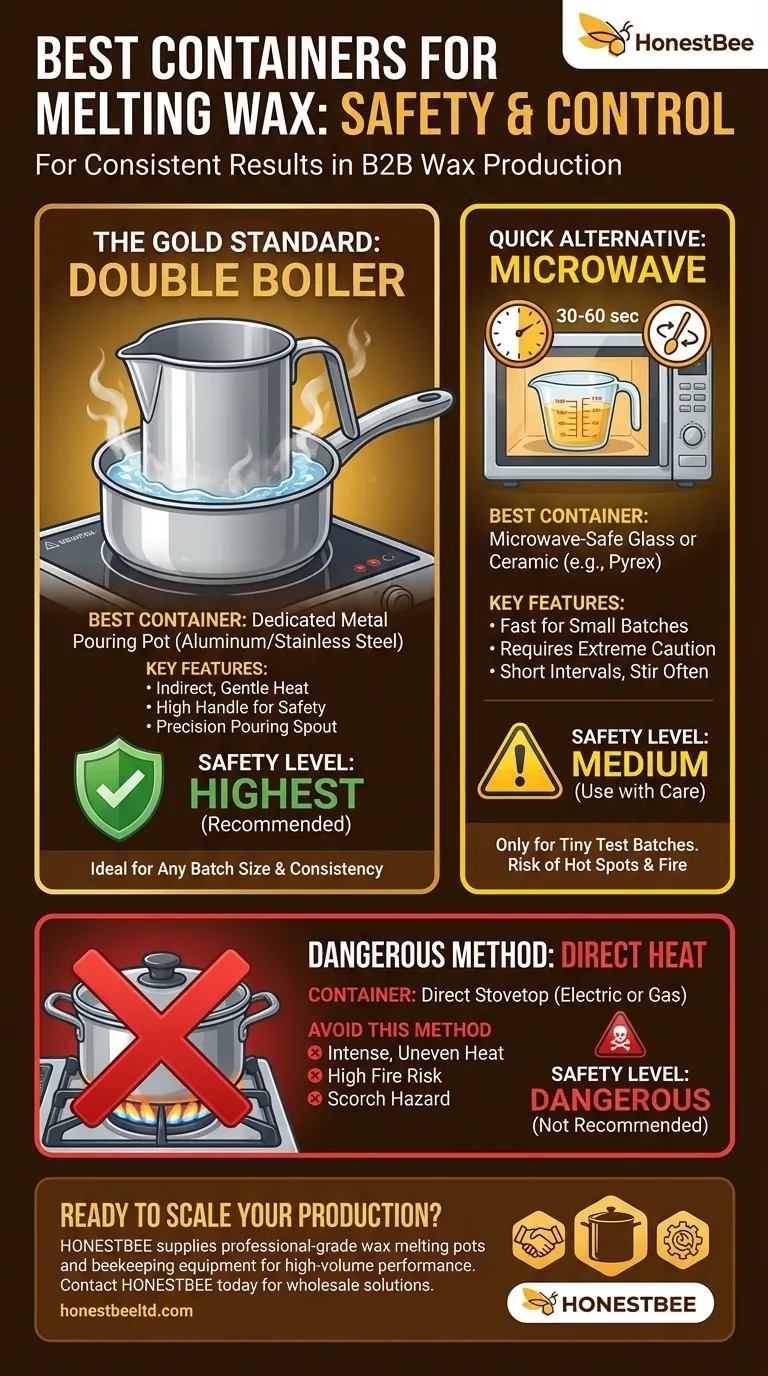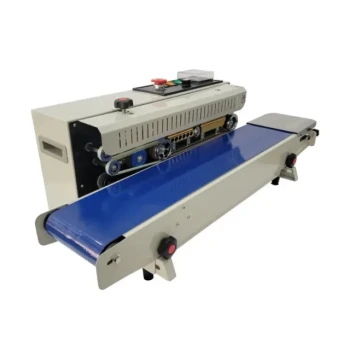The best container for melting wax is a dedicated metal wax melting pot used within a double boiler system. For small amounts, a microwave-safe glass or ceramic container can also be used, but this method requires extreme caution to prevent overheating and potential fire hazards.
The ideal container choice is dictated entirely by your melting method. While speed is tempting, prioritizing safety and control through indirect heat (like a double boiler) is the most critical factor for preventing accidents and achieving consistent results.

Choosing Your Melting Method and Container
The way you heat the wax directly determines the type of container you must use. The goal is always to apply gentle, even heat to avoid scorching the wax or, more dangerously, raising it to its flash point where it can auto-ignite.
The Gold Standard: The Double Boiler
This method uses a water bath to provide gentle, indirect heat, making it the safest and most recommended approach for beginners and professionals alike.
The Inner Pot (Pouring Pot)
A dedicated wax pouring pot is the ideal choice. These are typically made of aluminum or stainless steel, which conduct heat efficiently. Key features include a high handle to keep your hand away from the heat and a spout for precise, clean pouring.
The Outer Pot
This is simply a standard saucepan from your kitchen. It should be large enough to hold the inner pouring pot and a few inches of water, creating the "water bath" that buffers the wax from direct heat.
The Quick Alternative: The Microwave
Microwaving wax can be fast for very small batches, but it comes with significant risks if not done correctly. The primary danger is creating "hot spots" in the wax that can rapidly exceed safe temperatures.
The Right Container for Microwaving
You must use a container that is explicitly labeled "microwave-safe" or "heatproof." The best options are borosilicate glass (like Pyrex) or heavy ceramic containers. Never use plastic, as it can melt or warp, and avoid containers with metallic paint or trim.
The Process and Its Risks
When microwaving, heat the wax in very short intervals—30 to 60 seconds at a time—on medium power. Stir thoroughly between each interval to distribute the heat evenly and break up any hot spots. Never leave it unattended.
Understanding the Trade-offs
Choosing a container is a balance of safety, speed, and the volume of wax you need to melt. Understanding the risks of each method is non-negotiable.
Safety and Control (Double Boiler)
The double boiler method offers maximum control. The water bath ensures the wax temperature cannot rise much beyond the boiling point of water (212°F / 100°C), which is well below the flash point of most waxes. This is the slowest but safest method.
Speed vs. Risk (Microwave)
The microwave offers speed but sacrifices control. It's easy to accidentally superheat the wax, creating a serious fire hazard. This method is only suitable for tiny test batches and requires your full, undivided attention.
Why You Must Avoid Direct Heat
Never place a container of wax directly on an electric or gas stovetop. This provides intense, uneven heat that will scorch the wax and can quickly bring it to its flash point, causing a dangerous fire. This is the least safe method and should never be attempted.
Making the Right Choice for Your Goal
Your project's scale and your personal priority for safety should guide your decision.
- If your primary focus is safety, consistency, and batches of any size: Use a dedicated metal pouring pot within a double boiler setup.
- If your primary focus is quickly melting a very small test batch (a few ounces): Use a clearly marked "microwave-safe" glass or ceramic container, heating in short, supervised intervals.
- If your primary focus is scaling up production for a business: Invest in a dedicated, large-capacity electric wax melter with a built-in thermostat and spigot.
Ultimately, selecting the right container is the first step in ensuring a safe and successful wax melting process.
Summary Table:
| Method | Best Container Type | Key Features | Safety Level |
|---|---|---|---|
| Double Boiler | Dedicated Metal Pouring Pot (Aluminum/Stainless Steel) | Indirect, gentle heat; high handle; pouring spout | Highest (Recommended) |
| Microwave | Microwave-Safe Glass or Ceramic (e.g., Pyrex) | Fast for small batches; requires extreme caution | Medium (Use with Care) |
| Direct Stovetop | AVOID THIS METHOD | Intense, uneven heat; high fire risk | Dangerous (Not Recommended) |
Ready to Scale Your Beekeeping or Wax Production Safely?
For commercial apiaries and beekeeping equipment distributors, the right equipment is key to efficiency and safety. HONESTBEE supplies professional-grade wax melting pots and beekeeping supplies designed for high-volume, reliable performance.
Contact HONESTBEE today to explore our wholesale-focused product lines and discover how we can support your business growth with durable, purpose-built equipment.
Visual Guide

Related Products
- Beeswax Melter for Candle Making Honey Bee Wax Melter
- Steam Beeswax Melter Wax Warmer for Wax Processing
- Electric Beeswax Flat Sheet Machine with Operating Tray for Wax Processing
- Manual Beeswax Flat Sheet Machine for Beeswax Processing
- Honey Wax Separating Wax Press with Metal Screw Wax Separator Machine
People Also Ask
- What is the recommended temperature range for melting beeswax? Achieve Perfect Quality & Safety
- What is the best way to melt beeswax for candles? The Safest Method for Professional Results
- What are the main types of wax melters? Choose the Right Heating Method for Your Needs
- What do you use a wax melter for? From Home Fragrance to Professional Beekeeping
- How does a steam wax melter work? A Fast, Efficient Method for High-Quality Wax



















